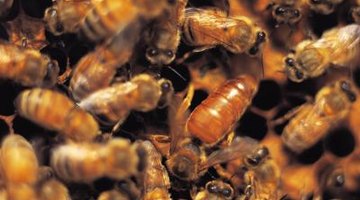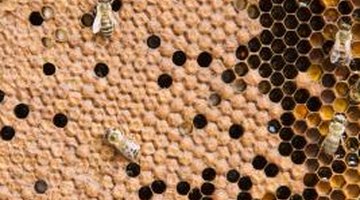Bees That Live in the Cinder Blocks of a House
Bees are beneficial insects that have a major impact on the ecosystems of the world. However, when a colony of highly social insects decides to build their home in the cinder blocks of a home, this can cause more problems than worrying about a few stings. Nest removal can be difficult, and it is important to weight the benefits and risks before deciding on a course of action.
Types of Bees


Not all types of bees will be attracted to the idea of building a nest in the cinder blocks of the home. Many species of bees are strictly ground-dwelling, while others prefer to lead solitary lives and make their homes in single accommodations. Honey bees are one of the types of bees that will seek out a suitable nesting location for a large colony, and when there are no other, more suitable locations, they will build their nests inside walls and in the hollows of blocks. Bumblebees also nest in large colonies, and prefer hollows and caverns that afford some kind of insulation against the elements. For them, the idea of nesting inside the thick walls of a cinder block can be enticing.
Dangers

Of the two most common species of bees that can be found nesting in the cinder blocks of a home, bumblebees are the more aggressive. These bees will typically defend their nests against activities they deem a threat. Honey bees will also defend their homes, but they will view fewer activities as a threat to their homes. When people are stung by honey bees, it's more commonly an accidental sting caused by stepping on the bee, or by picking a flower the bee has landed on.
When the nest is built in some of the fundamental building materials of a home, there can be another danger. Honey bee nests in particular can be massive, sprawling structures that produce large combs and large amounts of honey. When these combs melt in the summer heat, they can attract countless others pests, including other insects and small rodents.
Benefits

When they nest in the right spots, both bumblebees and honey bees can be highly beneficial to have around. They pollinate plants, enabling the growth of berries, fruits and vegetables, which might not otherwise be possible. The nests of honey bees can be harvested for their honey and honeycombs, and universities around the world are studying bee colonies in fields from medical research to bomb-finding technologies.
The full benefits of bees have yet to be explored, but what is known is that they play an instrumental role in the ecology of even our backyard environments. For this reason, it may be worth leaving the nest alone and letting the bees get on with their business if there is no immediate threat, and if there is no one in the family who is allergic to stings.
Nest Removal
If it is decided that the nest needs to be removed, doing so can be a chore. If the swarm is just settling in and the cinder blocks are not yet packed with nest materials, pesticides or insecticides made specifically for bees can be sprayed into the area every few days, until there is no sign of activity. Remove the nest with a garbage bag.
If the nest isn't discovered until farther along in the season, it may be easier to call a professional to do the removal as beehives can grow quite large. Pest-removal companies will come in and take care of the removal, but there are other options. Local beekeepers may be willing to come in and take the hive, relocating the swarm to their own properties. University extension offices may come to collect the bees for their research departments, and a government ecology office may be able to provide phone numbers of other agencies or individuals looking for bee swarms.
References
Photo Credits
- Photos.com/Photos.com/Getty Images
- Jupiterimages/Photos.com/Getty Images
- Jupiterimages/BananaStock/Getty Images
- Duncan Smith/Digital Vision/Getty Images
More Articles



